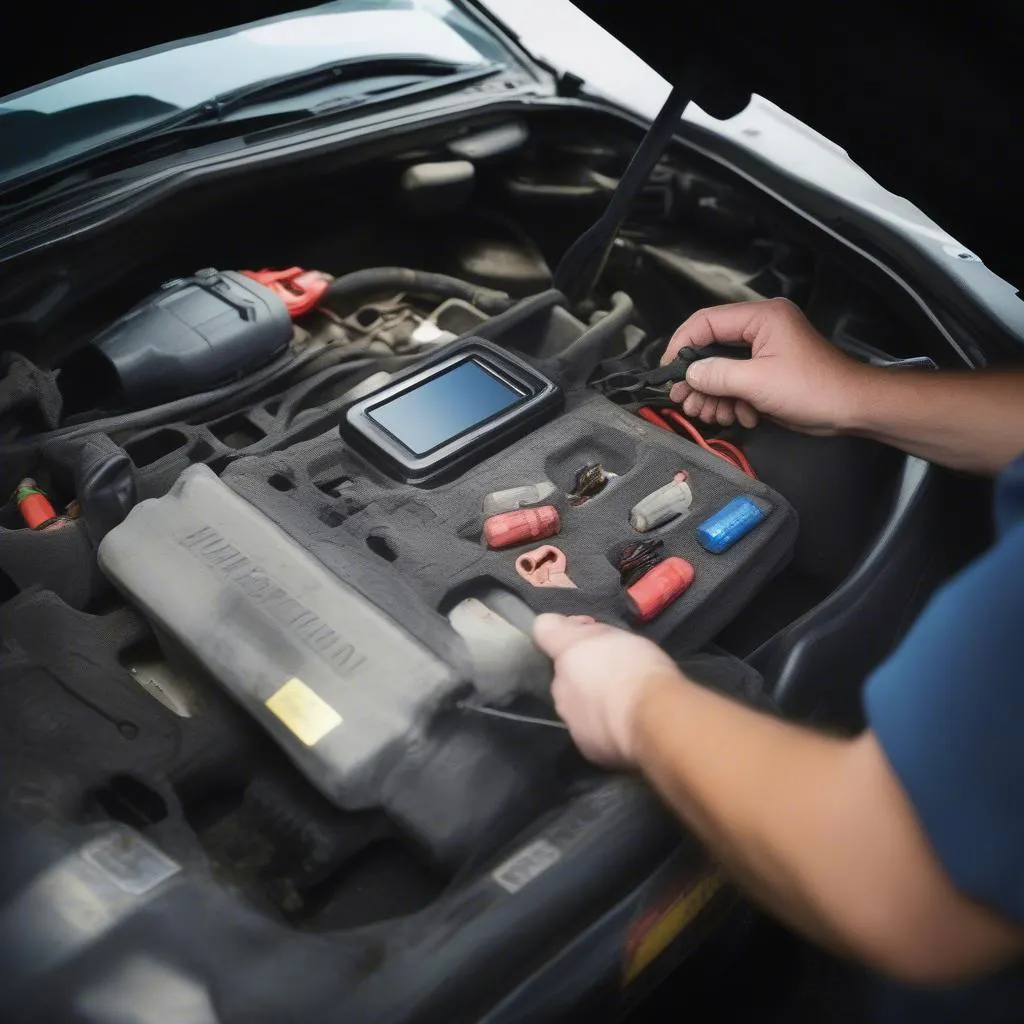The brake warning light on your Buick Rendezvous dashboard is a crucial safety feature, illuminating when the car detects a potential issue with your braking system. While it can be alarming, understanding the common causes of this warning light can help you address the problem effectively.
This comprehensive guide will delve into the potential reasons behind a Buick Rendezvous brake warning light and offer practical solutions to get you back on the road safely.
Decoding the Brake Warning Light
Your Buick Rendezvous brake warning light serves as a general indicator of braking system malfunctions. It can be triggered by various issues, ranging from minor to serious. Here are some possible culprits:
- Low Brake Fluid Level: This is one of the most common reasons for the brake warning light to illuminate. Brake fluid is essential for transmitting force from the brake pedal to the wheels, ensuring effective braking.
- Worn Brake Pads: Brake pads naturally wear down over time due to friction. When they become too thin, the brake warning light serves as a reminder for replacement.
- Faulty Brake Caliper: Brake calipers house the brake pads and pistons, applying pressure to the brake rotors to slow down or stop the vehicle. A sticking or seized caliper can cause uneven brake pad wear and trigger the warning light.
- ABS Issue: The Anti-lock Braking System (ABS) prevents wheel lockup during hard braking. If there’s a problem with the ABS module, sensors, or wiring, the brake warning light might come on.
- Brake Fluid Leak: A leak in the brake lines, hoses, or other components can lead to a drop in brake fluid level, compromising braking performance and illuminating the warning light.
- Parking Brake Engaged: While seemingly obvious, sometimes the parking brake might be slightly engaged, causing the warning light to stay on.
- Electrical Fault: A malfunctioning brake light switch or a short circuit in the wiring can also trigger the warning light.
Troubleshooting the Buick Rendezvous Brake Warning Light
Before attempting any repairs, it’s crucial to identify the root cause of the problem. Here’s a step-by-step guide to help you troubleshoot the brake warning light on your Buick Rendezvous:
- Check the Brake Fluid Level: Begin by inspecting the brake fluid level in the reservoir. If the level is low, add the recommended brake fluid type for your Buick Rendezvous.
- Inspect Brake Pads: Visually examine the brake pads through the wheel spokes. If they appear thin or worn down to the metal backing plate, it’s time for a replacement.
- Check for Brake Fluid Leaks: Look for signs of brake fluid leaks around the brake lines, hoses, calipers, and the master cylinder.
- Engage and Disengage the Parking Brake: Ensure the parking brake is fully released. Sometimes, even a slight engagement can trigger the warning light.
- Consult a Professional: If the brake warning light persists or you’re unable to diagnose the problem yourself, it’s essential to seek professional help.
The Importance of Addressing Brake Issues Promptly
Ignoring a brake warning light can have serious consequences, compromising your safety and potentially leading to expensive repairs. Addressing brake issues promptly ensures optimal braking performance and peace of mind while driving.
Remote Diagnostics and Software Solutions for Modern Vehicles
 Remote Diagnostics for Buick Rendezvous Brake Issues
Remote Diagnostics for Buick Rendezvous Brake Issues
Modern vehicles like the Buick Rendezvous are increasingly reliant on complex electronic systems, including the braking system. Remote diagnostics and software solutions are emerging as powerful tools to diagnose and address intricate car problems, including those related to the braking system.
- Remote Diagnostics: Specialized software allows technicians to access your vehicle’s computer system remotely, retrieving diagnostic trouble codes (DTCs), analyzing sensor data, and identifying potential issues without needing physical access to your car.
- Software Updates and Programming: Manufacturers often release software updates to improve vehicle performance, address known issues, and enhance safety features. Remote programming allows for these updates to be installed wirelessly, ensuring your Buick Rendezvous stays up-to-date.
These advancements in automotive technology offer convenience and efficiency, enabling quicker diagnoses and solutions for brake-related issues and beyond.
Expert Insight
“Regular brake system inspections are crucial for maintaining optimal safety. Don’t wait for the warning light to illuminate before addressing potential problems,” advises John Miller, an ASE-certified master technician with over 20 years of experience. “Modern remote diagnostics and software solutions are revolutionizing the way we diagnose and repair vehicles, making the process faster and more efficient.”
Conclusion
The brake warning light in your Buick Rendezvous is a critical safety indicator, demanding immediate attention. By understanding the common causes and following the troubleshooting steps outlined in this guide, you can address the problem effectively. If the issue persists, consulting a qualified mechanic is always recommended. Remember, a well-maintained braking system is fundamental for your safety and the safety of others on the road.

